The Not So Humble Apron
April 17th, 2013
For the past few weeks, I’ve been helping to install an exhibit of aprons (1880s-1970s) at the South County Historical Society. My job was purely technical — I did some minor wet cleaning, applied plenty of gentle steam to get the wrinkles out, and hand-sewed twill-tape supports until I was cross-eyed (thanks heavens I wasn’t alone on the steaming or sewing). But it got me thinking about aprons.
Of course, the primary point of an apron is to cover up — and often to protect — your clothing. They were (and are) worn by men and women alike, in different configurations according to the task at hand. But aprons weren’t always a matter of simple utility. From centuries past, right up to the 1960s, wealthy women — who never had to lift a finger for housework in their life — regularly wore “dress aprons” as part of their “at home” ensembles. Whether receiving guests in an 18th or 19th century parlor, or mixing cocktails for her husband’s office party, the well-dressed woman donned a frilly apron-shaped confection as a symbol of her domestic dominion.
“You will think I am dreaming when I tell you that a great many ladies have resumed aprons. This fashion is both graceful and convenient : it gives the toilet an air of simplicity which agrees well with le coin de feu…an air of delicate coquetry that is by no means to be disdained.”
The Ladies’ Companion, 1860
Dress aprons appeared frequently in fashion plates, like this one from Godey’s, as well as in the work table department of ladies’ magazines with diagrams for cutting and construction.

DESCRIPTION OF FASHION PLATE.
FIG. 1. – Muslin morning dress, made high in the neck. The corsage is a surplice shape, with bishop sleeves. Apron of plaid silk, trimmed with black lace. Muslin morning cap, trimmed with flowers. The tout ensemble of this dress is remarkable for its simplicity and beauty.
Godey’s Lady’s Book, October 1840; Philadelphia, PA.
Notice the decorative apron on the left? “Morning dress” was meant to be worn in the home, perhaps while receiving visitors making “morning calls,” which, ironically, were never made until afternoon. These formal 19th-century aprons often boasted elaborate decorations — I’ve seen one quite covered in silk-ribbon embroidery — and high, shaped waistbands supported by small pieces of whalebone.
APRONS
If for common use, aprons are made of white, brown, blue, black, or checked linen, of black stuff, calico, Holland, leather, nankeen, print, or long cloth ; if for better purposes, of cambric muslin, clear mulled, or jaconet muslin, silk, satinette, satin, &c. The length of the apron is, of course, generally determined by the height of the wearer, and the width, by that of the material, and by the purpose for which it is intended. For working aprons, the width is generally one breadth of a yard wide ; for dress aprons, two breadths, one of which is cut in half, and these halfs put one on each side of the whole breadth. If the material should be wide enough, one breadth, of from fourteen to twenty nails, will answer very well.
The Workwoman’s Guide, by a Lady; 1838, London.
There was also a distinction made between servants’ aprons that were meant to get dirty — worn while cooking, cleaning, or emptying the slops — and aprons that were meant to be seen.
“Before dinner is served she [the maid of all work] should again wash her hands and change her apron, making her dress as seemly as the nature of her employments permit.”
An Encyclopaedia of Domestic Economy, by Thomas Webster & Mrs. William Parkes; 1855, New York.
By the end of the 19th century, servants’ better aprons had become very formal indeed. Take this one for example. It belonged to someone in my maternal grandmother’s family — though as far as I know, none of them were ever in service.

I also have a number of aprons — both utilitarian and otherwise — that belonged to my grandmother herself, from 1940 through the 1970s.
Spinning My Wheels
January 9th, 2013
It seems I am well equipped for hand-spinning. Last weekend, I finally unpacked the boxes that held my wheels and other tools.
This is the wheel my grandfather rebuilt for me years ago when I first became interested in spinning. Someone in my grandmother’s guild was selling it, in need of a few repairs. I believe it was made in New Zealand. Despite having only one pedal (slightly trickier to use than double pedal wheels), it spins like a dream when it’s been properly adjusted. I need to put another leather thong on the pedal before I can use it.
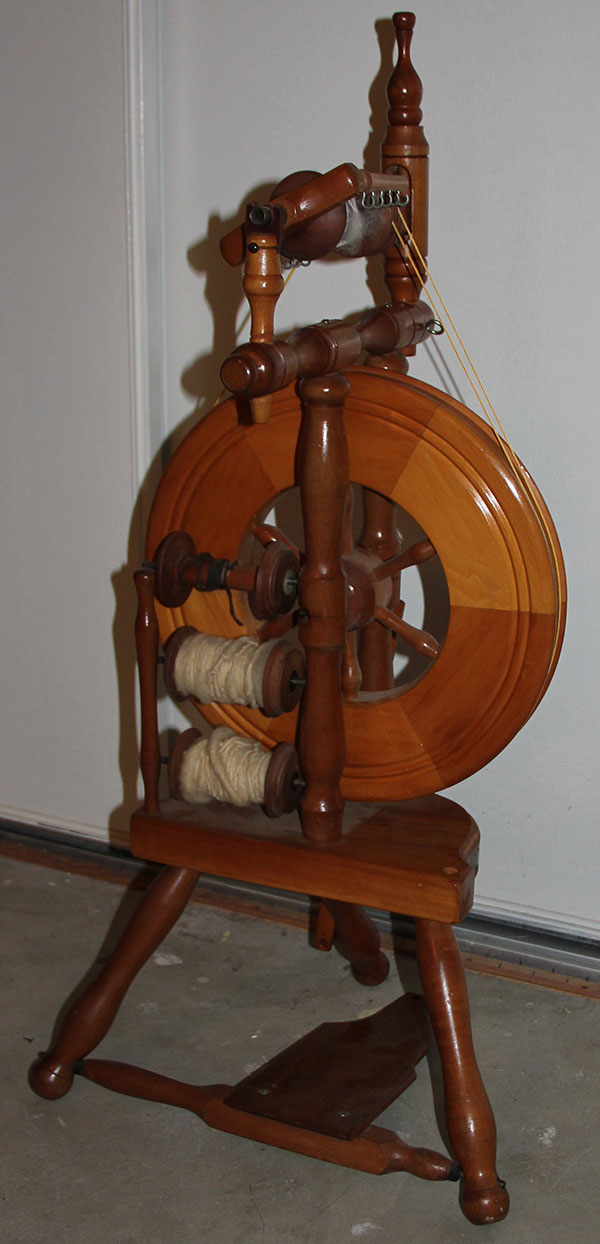
I also have one of my grandmother’s wheels.

Yeah, I probably don’t need two spinning wheels. But this one was custom built for her by my grandfather. It seemed like it should stay in the family. And the action is very different, thanks in part to the double pedals and compact shape. I need to repair the string that wraps around the wheel and makes it go.

Lest you think that a spinning wheel can stand alone, here’s a sampling of my other spinning tools. The two cross-like items on the left are called niddy-noddies. You wrap freshly spun yarn around them to set its twist and make a skein. One is mine, the other was Gram’s. There’s a selection of drop spindles — used to spin yarn without a wheel. My mother (whose interest in needlework is relatively limited, but intensely creative) says they are most effective when dropped off the balcony of a three story building. I’ve also got two sets of hand carders, mine and Gram’s. And Gram’s tiny carder, along with a leather shield to protect your lap from flying carders.

Last but not least, a drum carder. Serious spinners go through roving pretty quickly. Hand carding is slow and potentially painful (cramps and cuts). So my grandmother invested in a mechanical carding machine. Back in the 1980s, when she was learning to spin, there weren’t any internet sites selling pre-carded fibres…

I’ve got bags of hand-spun yarn in every color and material imaginable, all from Gram’s talented hands (waiting to be knitted up into family Christmas presents for many years to come). It’s a high standard to live up to, especially when I look at the pitifully lumpy yarn on the extra bobbins of my wheel. I think I’ll be spending a lot of time on this site, The Joy of Handspinning. Of course, I’ll need to dig out the box of fleece and fibres first…
Tip of the Iceberg
January 8th, 2013
I’m cleaning and organizing my sewing room/studio. And boy is it a gargantuan task. There are things here that have been hoarded for generations. Literally. I’m letting a lot of things move along (think purple polyester knitted fabric from the 1970s and piles of neon eyelash yarn). There are also some amazing treasures that I’d forgotten I had.

This autograph book belonged to my great-grandmother, Carrie Daugherty, neé Yonker. It’s fragile pages are filled with ornately penned poems and remembrances, some dated as early as 1879. I can recall sitting in my own grandmother’s sewing room, watching her turn the pages and listening to family stories.
The same box also contained a wealth of photographs from the first half of the 20th century, lots of old letters, and a bible that belonged to my great-grandmother’s great-aunt (born in 1812), bearing an inscription dated 1832.
Of course, the bulk of what I’m sorting through is fabric, yarn, and various needlework tools. Oh, and a fair slice of my grandmother’s wardrobe from 1930s through 1970s. But that’s another post entirely.
Cottage Loaves
July 7th, 2012
A few years ago, while I was researching the shape and size of mid-19th century bread loaves for a museum display, my grandmother sent me her own mother’s (my great-grandmother’s) bread pans.
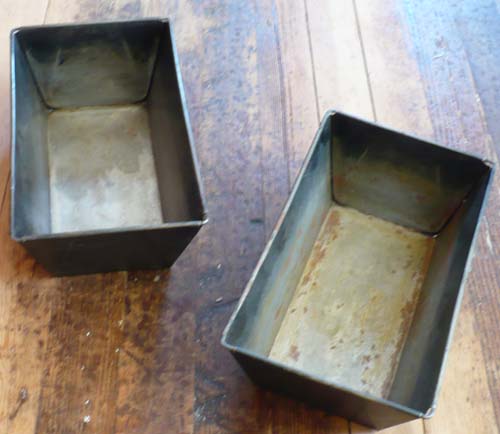
They’re tin, and liable to rust if not dried properly after washing. Notice how they are formed from sheets of metal folded over a rectangle of thick wire — you can really see it at the corners where the wire is uncovered. If my great-grandmother got them new, they’re about 100 years old. But of course, she may have inherited them herself!
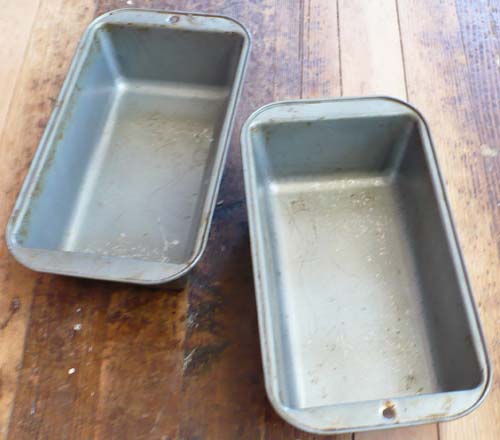
I prefer to bake in my own modern pans. They’re some sort of base metal covered in a smooth no-stick coating. Much easier to wash. And the museum professional in me feels better using “reproductions” and keeping the originals for display or study…
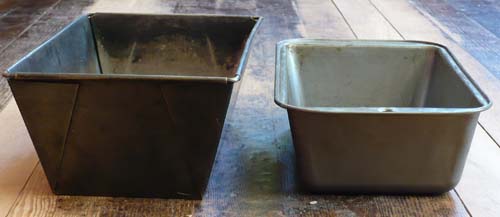
Notice the difference in pan size though! My modern pan (on the right) isn’t small by today’s standards. They weren’t kidding about their bread back then.
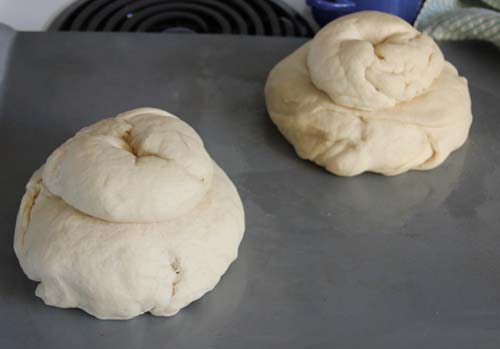
Of course, you don’t need pans at all to bake a beautiful loaf. In the middle of the 19th century, when baking implements were still prohibitively expensive or simply unavailable, many housewives made “cottage loaves.”
“…Divide it [the twice-risen bread dough] into two portions, one larger than the other, and make each into a smooth ball without cracks, placing the smaller on top of the other, and pressing the forefinger into the centre on the top…”
The St. James’s Cookery Book, Louisa Rochfort, 1894
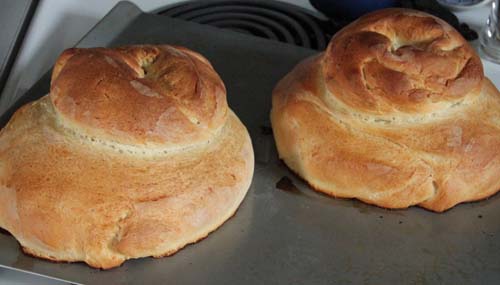
I made these loaves for Christmas brunch last year. I was staying at my mother’s house and didn’t have any bread pans…
Aprons, Part 7
May 23rd, 2012
I’m running out of things to say about aprons.
Today’s pairing features stylized flowers — they scream 1950s to me, but they could also be from the 1970s, when 1950s style saw a resurgence (think Happy Days, Grease).
Number one is pretty basic, relying on the printed fabric for decorative effect.

And a more elaborate apron of geometric daisies with red trim and patch pockets.

